Narges Norouzi
Your ViT is Secretly an Image Segmentation Model
Mar 24, 2025Abstract:Vision Transformers (ViTs) have shown remarkable performance and scalability across various computer vision tasks. To apply single-scale ViTs to image segmentation, existing methods adopt a convolutional adapter to generate multi-scale features, a pixel decoder to fuse these features, and a Transformer decoder that uses the fused features to make predictions. In this paper, we show that the inductive biases introduced by these task-specific components can instead be learned by the ViT itself, given sufficiently large models and extensive pre-training. Based on these findings, we introduce the Encoder-only Mask Transformer (EoMT), which repurposes the plain ViT architecture to conduct image segmentation. With large-scale models and pre-training, EoMT obtains a segmentation accuracy similar to state-of-the-art models that use task-specific components. At the same time, EoMT is significantly faster than these methods due to its architectural simplicity, e.g., up to 4x faster with ViT-L. Across a range of model sizes, EoMT demonstrates an optimal balance between segmentation accuracy and prediction speed, suggesting that compute resources are better spent on scaling the ViT itself rather than adding architectural complexity. Code: https://www.tue-mps.org/eomt/.
Beyond the Hype: A Comprehensive Review of Current Trends in Generative AI Research, Teaching Practices, and Tools
Dec 19, 2024



Abstract:Generative AI (GenAI) is advancing rapidly, and the literature in computing education is expanding almost as quickly. Initial responses to GenAI tools were mixed between panic and utopian optimism. Many were fast to point out the opportunities and challenges of GenAI. Researchers reported that these new tools are capable of solving most introductory programming tasks and are causing disruptions throughout the curriculum. These tools can write and explain code, enhance error messages, create resources for instructors, and even provide feedback and help for students like a traditional teaching assistant. In 2024, new research started to emerge on the effects of GenAI usage in the computing classroom. These new data involve the use of GenAI to support classroom instruction at scale and to teach students how to code with GenAI. In support of the former, a new class of tools is emerging that can provide personalized feedback to students on their programming assignments or teach both programming and prompting skills at the same time. With the literature expanding so rapidly, this report aims to summarize and explain what is happening on the ground in computing classrooms. We provide a systematic literature review; a survey of educators and industry professionals; and interviews with educators using GenAI in their courses, educators studying GenAI, and researchers who create GenAI tools to support computing education. The triangulation of these methods and data sources expands the understanding of GenAI usage and perceptions at this critical moment for our community.
ALGM: Adaptive Local-then-Global Token Merging for Efficient Semantic Segmentation with Plain Vision Transformers
Jun 14, 2024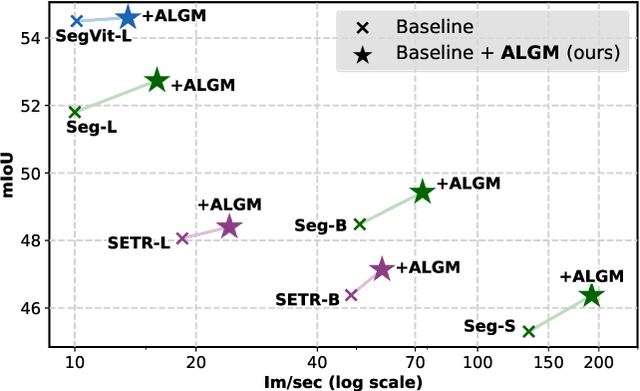
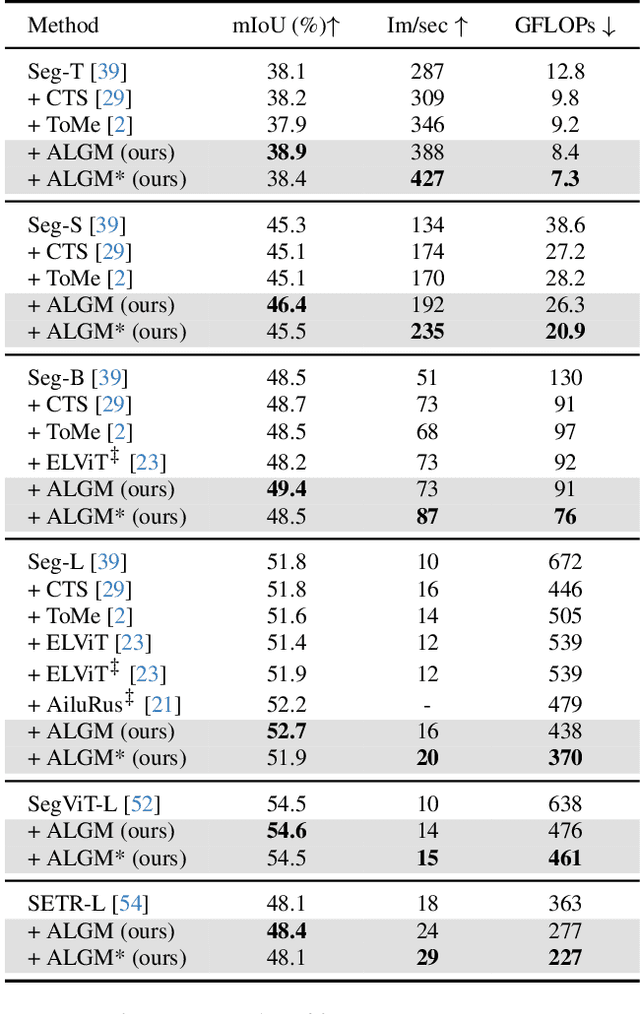
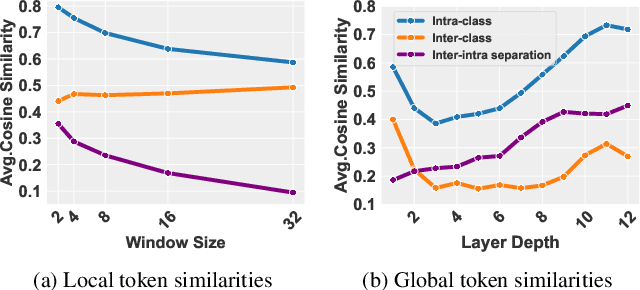

Abstract:This work presents Adaptive Local-then-Global Merging (ALGM), a token reduction method for semantic segmentation networks that use plain Vision Transformers. ALGM merges tokens in two stages: (1) In the first network layer, it merges similar tokens within a small local window and (2) halfway through the network, it merges similar tokens across the entire image. This is motivated by an analysis in which we found that, in those situations, tokens with a high cosine similarity can likely be merged without a drop in segmentation quality. With extensive experiments across multiple datasets and network configurations, we show that ALGM not only significantly improves the throughput by up to 100%, but can also enhance the mean IoU by up to +1.1, thereby achieving a better trade-off between segmentation quality and efficiency than existing methods. Moreover, our approach is adaptive during inference, meaning that the same model can be used for optimal efficiency or accuracy, depending on the application. Code is available at https://tue-mps.github.io/ALGM.
A Knowledge-Component-Based Methodology for Evaluating AI Assistants
Jun 09, 2024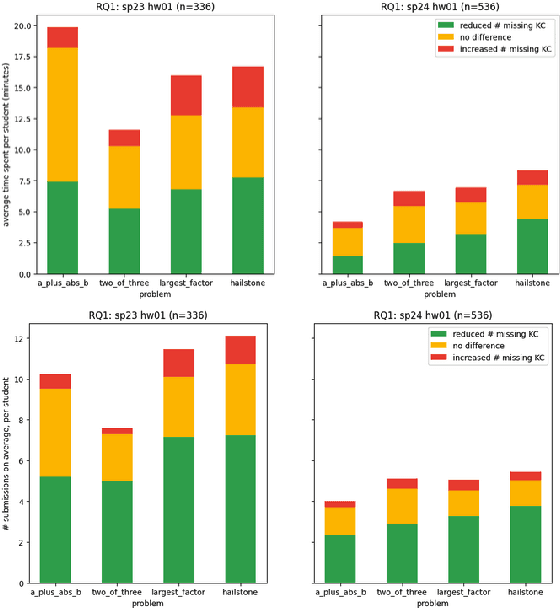
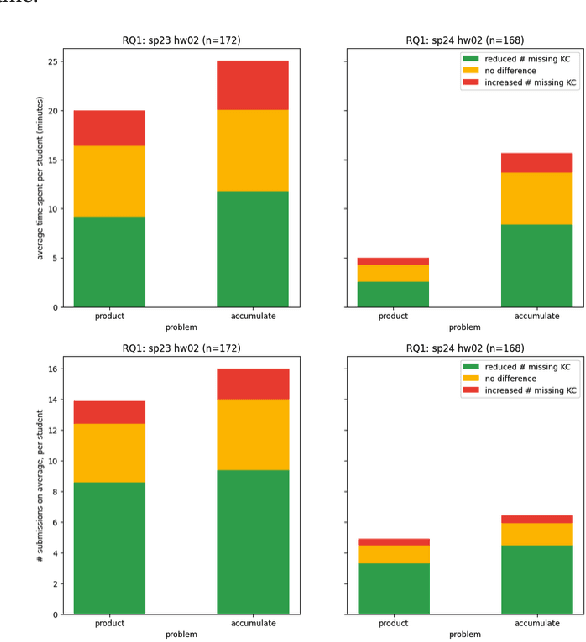
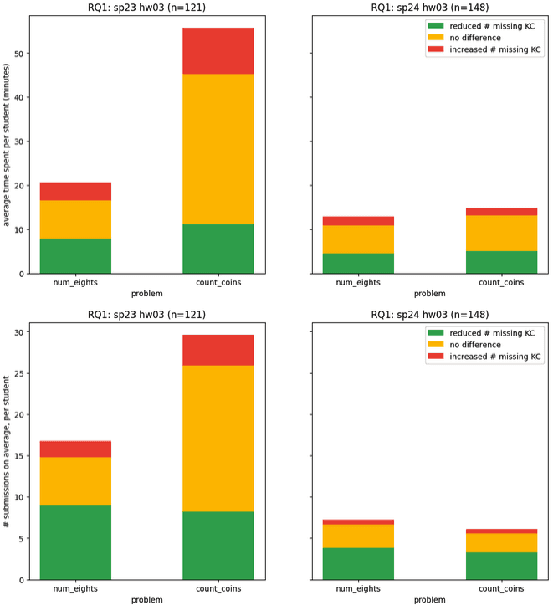
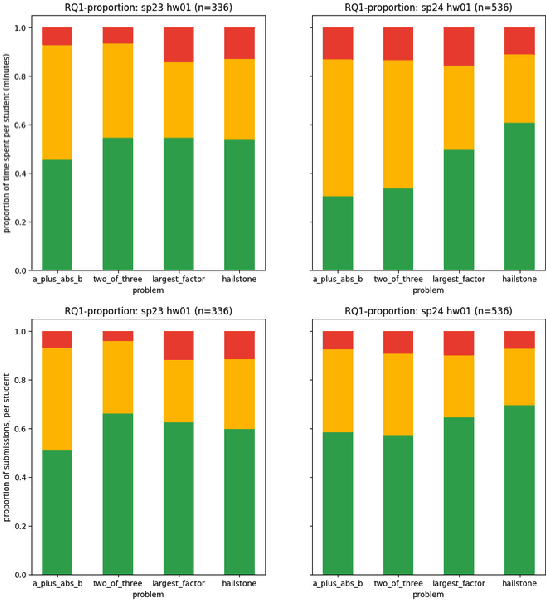
Abstract:We evaluate an automatic hint generator for CS1 programming assignments powered by GPT-4, a large language model. This system provides natural language guidance about how students can improve their incorrect solutions to short programming exercises. A hint can be requested each time a student fails a test case. Our evaluation addresses three Research Questions: RQ1: Do the hints help students improve their code? RQ2: How effectively do the hints capture problems in student code? RQ3: Are the issues that students resolve the same as the issues addressed in the hints? To address these research questions quantitatively, we identified a set of fine-grained knowledge components and determined which ones apply to each exercise, incorrect solution, and generated hint. Comparing data from two large CS1 offerings, we found that access to the hints helps students to address problems with their code more quickly, that hints are able to consistently capture the most pressing errors in students' code, and that hints that address a few issues at once rather than a single bug are more likely to lead to direct student progress.
EIT: Earnest Insight Toolkit for Evaluating Students' Earnestness in Interactive Lecture Participation Exercises
Oct 31, 2023Abstract:In today's rapidly evolving educational landscape, traditional modes of passive information delivery are giving way to transformative pedagogical approaches that prioritize active student engagement. Within the context of large-scale hybrid classrooms, the challenge lies in fostering meaningful and active interaction between students and course content. This study delves into the significance of measuring students' earnestness during interactive lecture participation exercises. By analyzing students' responses to interactive lecture poll questions, establishing a clear rubric for evaluating earnestness, and conducting a comprehensive assessment, we introduce EIT (Earnest Insight Toolkit), a tool designed to assess students' engagement within interactive lecture participation exercises - particularly in the context of large-scale hybrid classrooms. Through the utilization of EIT, our objective is to equip educators with valuable means of identifying at-risk students for enhancing intervention and support strategies, as well as measuring students' levels of engagement with course content.
FEDD -- Fair, Efficient, and Diverse Diffusion-based Lesion Segmentation and Malignancy Classification
Jul 21, 2023Abstract:Skin diseases affect millions of people worldwide, across all ethnicities. Increasing diagnosis accessibility requires fair and accurate segmentation and classification of dermatology images. However, the scarcity of annotated medical images, especially for rare diseases and underrepresented skin tones, poses a challenge to the development of fair and accurate models. In this study, we introduce a Fair, Efficient, and Diverse Diffusion-based framework for skin lesion segmentation and malignancy classification. FEDD leverages semantically meaningful feature embeddings learned through a denoising diffusion probabilistic backbone and processes them via linear probes to achieve state-of-the-art performance on Diverse Dermatology Images (DDI). We achieve an improvement in intersection over union of 0.18, 0.13, 0.06, and 0.07 while using only 5%, 10%, 15%, and 20% labeled samples, respectively. Additionally, FEDD trained on 10% of DDI demonstrates malignancy classification accuracy of 81%, 14% higher compared to the state-of-the-art. We showcase high efficiency in data-constrained scenarios while providing fair performance for diverse skin tones and rare malignancy conditions. Our newly annotated DDI segmentation masks and training code can be found on https://github.com/hectorcarrion/fedd.
HealNet -- Self-Supervised Acute Wound Heal-Stage Classification
Jun 23, 2022



Abstract:Identifying, tracking, and predicting wound heal-stage progression is a fundamental task towards proper diagnosis, effective treatment, facilitating healing, and reducing pain. Traditionally, a medical expert might observe a wound to determine the current healing state and recommend treatment. However, sourcing experts who can produce such a diagnosis solely from visual indicators can be difficult, time-consuming and expensive. In addition, lesions may take several weeks to undergo the healing process, demanding resources to monitor and diagnose continually. Automating this task can be challenging; datasets that follow wound progression from onset to maturation are small, rare, and often collected without computer vision in mind. To tackle these challenges, we introduce a self-supervised learning scheme composed of (a) learning embeddings of wound's temporal dynamics, (b) clustering for automatic stage discovery, and (c) fine-tuned classification. The proposed self-supervised and flexible learning framework is biologically inspired and trained on a small dataset with zero human labeling. The HealNet framework achieved high pre-text and downstream classification accuracy; when evaluated on held-out test data, HealNet achieved 97.7% pre-text accuracy and 90.62% heal-stage classification accuracy.
SnapMode: An Intelligent and Distributed Large-Scale Fashion Image Retrieval Platform Based On Big Data and Deep Generative Adversarial Network Technologies
Apr 08, 2022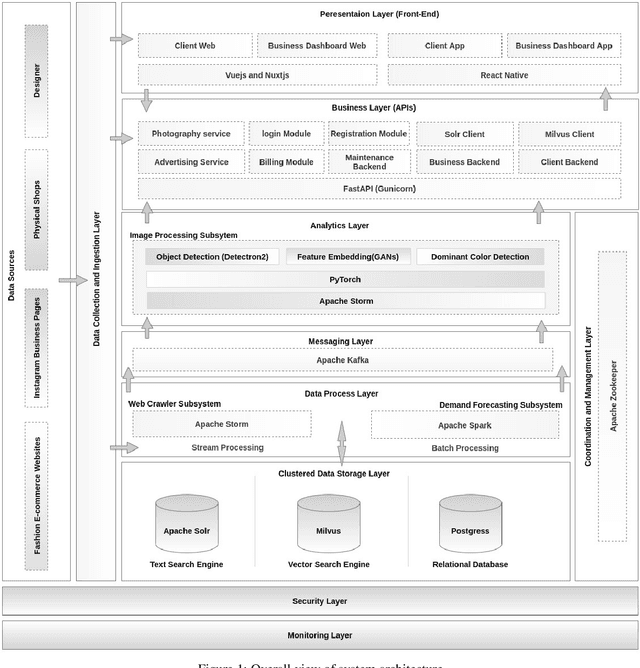
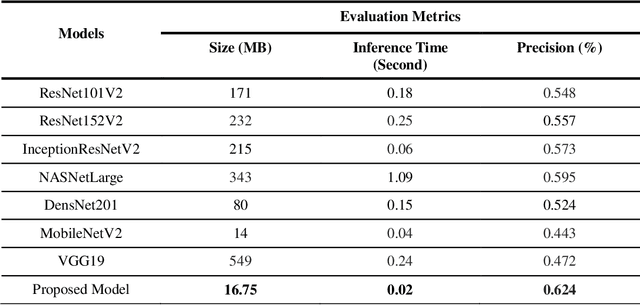
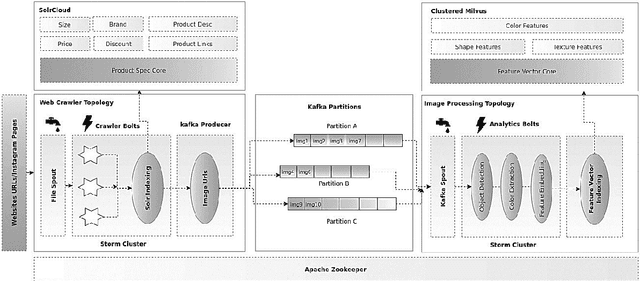
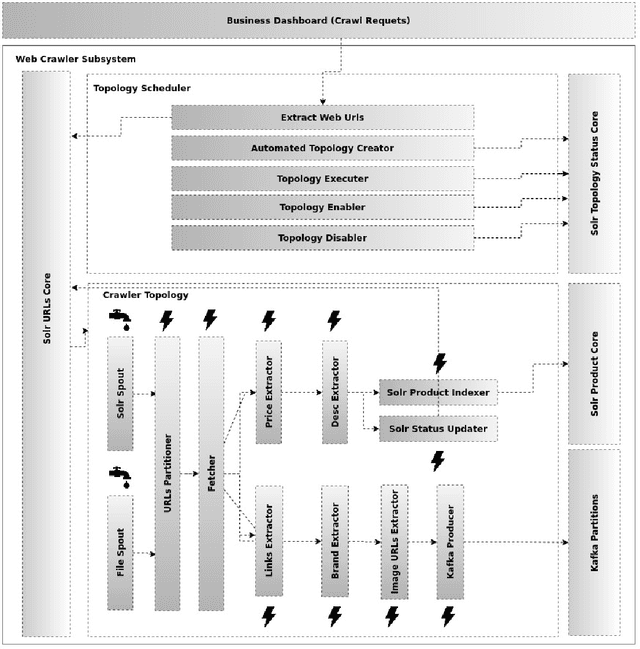
Abstract:Fashion is now among the largest industries worldwide, for it represents human history and helps tell the worlds story. As a result of the Fourth Industrial Revolution, the Internet has become an increasingly important source of fashion information. However, with a growing number of web pages and social data, it is nearly impossible for humans to manually catch up with the ongoing evolution and the continuously variable content in this domain. The proper management and exploitation of big data can pave the way for the substantial growth of the global economy as well as citizen satisfaction. Therefore, computer scientists have found it challenging to handle e-commerce fashion websites by using big data and machine learning technologies. This paper first proposes a scalable focused Web Crawler engine based on the distributed computing platforms to extract and process fashion data on e-commerce websites. The role of the proposed platform is then described in developing a disentangled feature extraction method by employing deep convolutional generative adversarial networks (DCGANs) for content-based image indexing and retrieval. Finally, the state-of-the-art solutions are compared, and the results of the proposed approach are analyzed on a standard dataset. For the real-life implementation of the proposed solution, a Web-based application is developed on Apache Storm, Kafka, Solr, and Milvus platforms to create a fashion search engine called SnapMode.
A New Automatic Change Detection Frame-work Based on Region Growing and Weighted Local Mutual Information: Analysis of Breast Tumor Response to Chemotherapy in Serial MR Images
Oct 19, 2021



Abstract:The automatic analysis of subtle changes between longitudinal MR images is an important task as it is still a challenging issue in scope of the breast medical image processing. In this paper we propose an effective automatic change detection framework composed of two phases since previously used methods have features with low distinctive power. First, in the preprocessing phase an intensity normalization method is suggested based on Hierarchical Histogram Matching (HHM) that is more robust to noise than previous methods. To eliminate undesirable changes and extract the regions containing significant changes the proposed Extraction Region of Changes (EROC) method is applied based on intensity distribution and Hill-Climbing algorithm. Second, in the detection phase a region growing-based approach is suggested to differentiate significant changes from unreal ones. Due to using proposed Weighted Local Mutual Information (WLMI) method to extract high level features and also utilizing the principle of the local consistency of changes, the proposed approach enjoys reasonable performance. The experimental results on both simulated and real longitudinal Breast MR Images confirm the effectiveness of the proposed framework. Also, this framework outperforms the human expert in some cases which can detect many lesion evolutions that are missed by expert.
 Add to Chrome
Add to Chrome Add to Firefox
Add to Firefox Add to Edge
Add to Edge